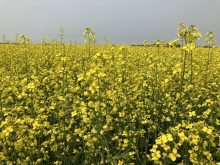THE PERCEPTION that feeding the world’s population will become a more challenging task promises to make agricultural land more valuable.
That is attracting the attention of investors who are adding a new element to the ownership and management of prairie farmland though a desire to own or manage vast acreages.
Either way, it changes the status quo and offers opportunities but also concerns for the rural economy and society.
On the management side of the trend is One Earth Farms, a partnership of 18 First Nations and Sprott Resources Corp., a Toronto-based investment company. It will manage grain and livestock production on First Nations land in Alberta and Saskatchewan, and intends to invest $27.5 million to launch the project, and farm 50,000 acres in the first year.
Read Also

Growth plates are instrumental in shaping a horse’s life
Young horse training plans and workloads must match their skeletal development. Failing to plan around growth plates can create lifelong physical problems.
Much of the land was bought by First Nations in the last 15 years as part of land claim settlements and has been leased by neighbouring farmers, but as those leases expire, One Earth will likely increase its area under management, with a goal of one million acres.
Active on the ownership side of this new land rush are companies such as Calgary-based AgCapita and Regina-based Agriculture Development Corp. (ADC).
They have attracted hundreds of millions of dollars from investors to buy prairie farmland and the land is often rented back to the farmers who sold it. The attractions for investors are rental income and capital appreciation of the land.
These ventures offer clear benefits for agriculture and rural people.
First Nation reserves suffer from high unemployment among their large, young populations and yet neighbouring farms, run by an aging demographic, suffer chronic labour shortages.
One Earth is working with First Nations to train young aboriginal people, developing a new agricultural talent pool.
Prairie agriculture also suffered from a weak land market. AgCapita and ADC provide new non-agriculture investment to buy land from retiring farmers or from producers who want to continue farming but don’t want their capital tied up in land.
These young companies are too small to transform rural life. But if this trend grows, it could make a difference.
If land under central management was counted in the millions of acres, with management controlling costs by buying inputs and equipment in bulk directly from manufacturers, local farm machinery and supply dealerships would suffer.
If huge corporate farms gained a high profile, it could change consumers’ trust in farmers, now rooted in the appealing image of the owner-operator committed to sustainable stewardship. In opinion polls, farmers rate with firefighters and nurses at the top of more trusted professions.
Another food scare like the one in early 2008 could attract a tide of investment into agricultural land, from Canada and abroad. Saudi Arabia, South Korea and China are investing billions in farming, mostly in Africa and Asia now, but it is conceivable that some of that money could come here.
If corporate ownership becomes an established trend, it will have to develop carefully and with civic mindedness to maintain the rural economy and the bonds of trust between food producer and consumer.
Bruce Dyck, Terry Fries, Barb Glen, D’Arce McMillan and Ken Zacharias collaborate in the writing of Western Producer editorials.














